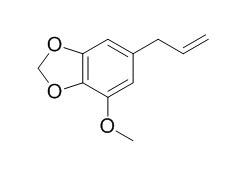Myristicin
Myristicin has anti-cholinergic, antibacterial, and hepatoprotective effects, it also has anti-inflammatory properties related with its inhibition of NO, cytokines,chemokines, and growth factors in dsRNA-stimulated macrophages via the calcium pathway. Myristicin may antagonize the anxiolytic effects of midazolam, increase anxiety, and affect motor movements. Myristicin can induce apoptosis as characterised by alterations in the mitochondrial membrane potential, cytochrome c release, caspase-3 activation, PARP-cleavage and DNA fragmentation.
Inquire / Order:
manager@chemfaces.com
Technical Inquiries:
service@chemfaces.com
Tel:
+86-27-84237783
Fax:
+86-27-84254680
Address:
1 Building, No. 83, CheCheng Rd., Wuhan Economic and Technological Development Zone, Wuhan, Hubei 430056, PRC
Providing storage is as stated on the product vial and the vial is kept tightly sealed, the product can be stored for up to
24 months(2-8C).
Wherever possible, you should prepare and use solutions on the same day. However, if you need to make up stock solutions in advance, we recommend that you store the solution as aliquots in tightly sealed vials at -20C. Generally, these will be useable for up to two weeks. Before use, and prior to opening the vial we recommend that you allow your product to equilibrate to room temperature for at least 1 hour.
Need more advice on solubility, usage and handling? Please email to: service@chemfaces.com
The packaging of the product may have turned upside down during transportation, resulting in the natural compounds adhering to the neck or cap of the vial. take the vial out of its packaging and gently shake to let the compounds fall to the bottom of the vial. for liquid products, centrifuge at 200-500 RPM to gather the liquid at the bottom of the vial. try to avoid loss or contamination during handling.
Srinagarind Medical Journal2019, 34(1)
Biomedicine & Pharmacotherapy2020, 125:109950
Pest Manag Sci.2023, 79(8):2675-2685.
Food Research International2023, 113792.
J Nat Med.2021, doi: 10.1007.
J Adv Res.2021, 35:245-257.
Molecules.2019, 24(24):E4536
Development.2024, 151(20):dev202518.
Chinese J of Tissue Engineering Res.2022, 26(17): 2636-2641.
Heliyon.2024, 10(7):e28755.
Related and Featured Products
Molecules. 2011;16(8):7132-42.
Anti-inflammatory effect of myristicin on RAW 264.7 macrophages stimulated with polyinosinic-polycytidylic acid.[Pubmed:
21991618]
Myristicin (1-allyl-5-methoxy-3,4-methylenedioxybenzene) is an active aromatic compound found in nutmeg (the seed of Myristica fragrans), carrot, basil,cinnamon, and parsley. Myristicin has been known to have anti-cholinergic, antibacterial,and hepatoprotective effects, however, the effects of Myristicin on virus-stimulated macrophages are not fully reported.
METHODS AND RESULTS:
In this study, the anti-inflammatory effect of Myristicin on double-stranded RNA (dsRNA)-stimulated macrophages was examined. Myristicin did not reduce the cell viability of RAW 264.7 mouse macrophages at concentrations of up to 50 μM. Myristicin significantly inhibited the production of calcium, nitric oxide (NO),interleukin (IL)-6, IL-10, interferon inducible protein-10, monocyte chemotactic protein(MCP)-1, MCP-3, granulocyte-macrophage colony-stimulating factor, macrophage inflammatory protein (MIP)-1α, MIP-1β, and leukemia inhibitory factor in dsRNA[polyinosinic-polycytidylic acid]-induced RAW 264.7 cells (P < 0.05).
CONCLUSIONS:
In conclusion,Myristicin has anti-inflammatory properties related with its inhibition of NO, cytokines,chemokines, and growth factors in dsRNA-stimulated macrophages via the calcium pathway.
AANA J. 2011 Apr;79(2):109-14.
Evaluation of the anxiolytic properties of myristicin, a component of nutmeg, in the male Sprague-Dawley rat.[Pubmed:
21560973]
The purpose of this study was to investigate the anxiolytic effects of Myristicin, a major compound found in nutmeg, and its potential interaction with the gamma-aminobutyric acid (GABA(A)) receptor in male Sprague-Dawley rats.
METHODS AND RESULTS:
Nutmeg has traditionally been used as a spice in food preparation and as an herbal remedy in the treatment of many medical conditions, including anxiety. Fifty-five rats were divided equally into 5 groups: control (vehicle); Myristicin; midazolam (positive control); flumazenil and Myristicin; and midazolam and Myristicin. The behavioral component of anxiety was examined by using the elevated plus-maze (open-arm and closed-arm times) along with analysis of gross and fine motor movements. Data analysis was performed using a 2-tailed multivariate analysis of variance (MANOVA) and least significant difference post-hoc test.
CONCLUSIONS:
Our data suggest that Myristicin does not decrease anxiety by modulation of the GABA(A) receptor but may promote anxiogenesis. When Myristicin was combined with midazolam, an antagonist-like effect similar to the flumazenil and Myristicin combination was exhibited by a decrease in anxiolysis compared with the midazolam-only group. Myristicin may antagonize the anxiolytic effects of midazolam, increase anxiety, and affect motor movements.
Chem Biol Interact. 2014 Jul 25;218:1-9.
Myristicin from nutmeg induces apoptosis via the mitochondrial pathway and down regulates genes of the DNA damage response pathways in human leukaemia K562 cells.[Pubmed:
24792648]
Myristicin, an allylbenzene, is a major active component of various spices, such as nutmeg and cinnamon, plants from the Umbelliferae family or in some essential oils, such as oils of clove or marjoram. Human exposure to Myristicin is low but widespread due to consumption of these spices and essential oils, added to food (e.g. cola drinks) or in traditional medicine. Occasionally high dose exposure occurs, leading to various clinical symptoms, however the molecular mechanisms underlying them are unknown.
Our previous studies revealed that Myristicin is not genotoxic and yet presented apoptotic activity.
METHODS AND RESULTS:
Therefore, in this work we assessed the apoptotic mechanisms induced by Myristicin in human leukaemia cells. In order to gain further insight on the potential of Myristicin to modulate gene expression we also analysed alterations in expression of 84 genes associated with the DNA damage response pathway. The results obtained show that Myristicin can induce apoptosis as characterised by alterations in the mitochondrial membrane potential, cytochrome c release, caspase-3 activation, PARP-cleavage and DNA fragmentation. The gene expression profile revealed an overall down regulation of DNA damage response genes after exposure to Myristicin, with significant under-expression of genes associated with nucleotide excision repair (ERCC1), double strand break repair (RAD50, RAD51) and DNA damage signalling (ATM) and stress response (GADD45A, GADD45G).
CONCLUSIONS:
On the whole, we demonstrate that Myristicin can alter mitochondrial membrane function, induce apoptosis and modulate gene expression in human leukaemia K562 cells. This study provides further detail on the molecular mechanisms underlying the biological activity of Myristicin.



